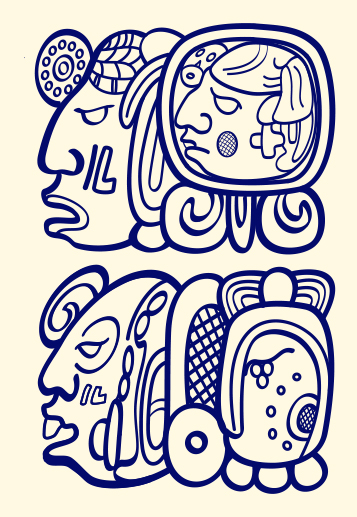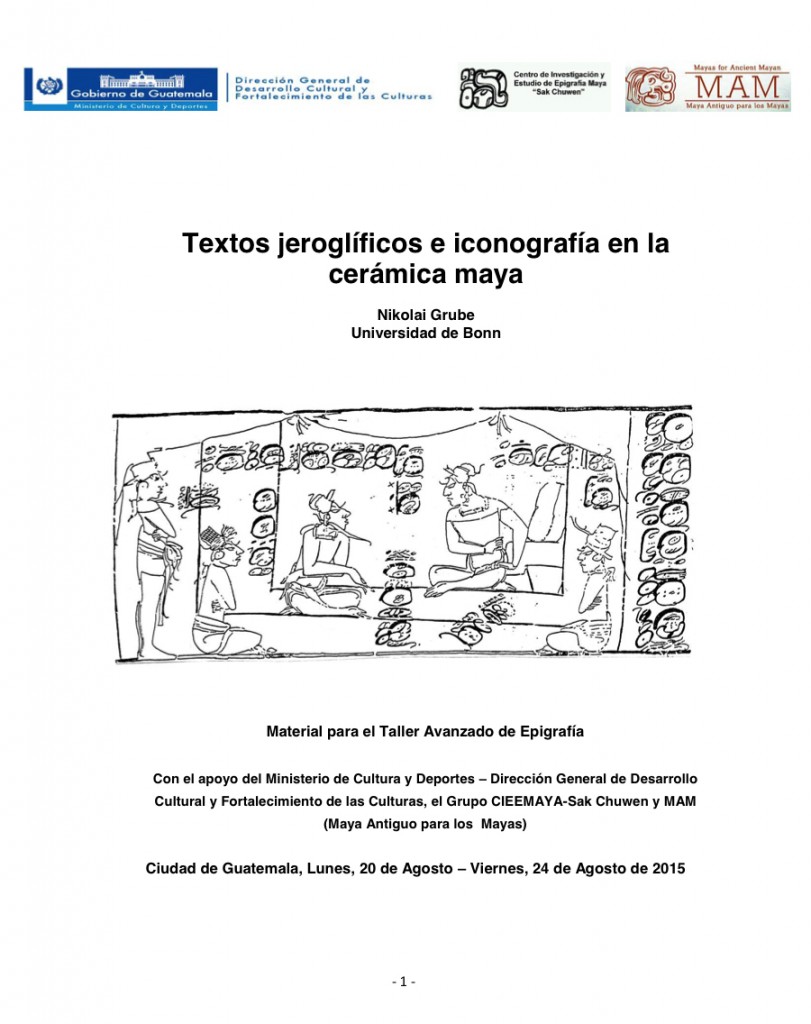MAM is always grateful when we are part of a team effort. Dr. Grube has been giving advanced workshops for Guatemalans ever since the early days of Linda Schele, and he continues to do so with the organizational support of the Sak Chuwen Group. MAM is happy to play a modest role in this annual event in which Maya epigraphers advance their knowledge.
Bruce Love, President
MAM
ADVANCED WORKSHOP BY NIKOLAI GRUBE
July 2015
By: The Sak Chuwen Group
Introduction
From July 20 to 26, an advanced workshop in Maya epigraphy took place with great success in Guatemala City. The workshop titled “Hieroglyphic Texts and Iconography on Maya Ceramics” was led by Profesor Nikolai Grube from the University of Bonn. The workshop consisted of a series of activities that included lectures by Grube, group exercises, and a visit to various archaeological sites with the goal of reinforcing the knowledge gained during the classes.
The course was given to forty-five Mayan-speaking students from eight language communities. The following describes in more detail the various activities.
En MAM estamos hemos agradecido siempre ser parte de un esfuerzo de equipo. El Dr. Grube ha estado impartiendo talleres avanzados para los guatemaltecos desde los tiempos de sus primeras colaboraciones con Linda Schele y continúa haciéndolo con el apoyo organizacional del Grupo Sak Chuwen. En MAM estamos muy contentos de jugar un modesto papel en este evento anual que los epigrafistas mayas aprovechan para expandir sus conocimientos.
Bruce Love, Presidente
MAM
TALLER AVANZADO DE NIKOLAI GRUBE
Julio 2015
Por: Grupo Sak Chuwen
Introducción
Del 20 al 26 de julio se llevó a cabo exitosamente en la ciudad de Guatemala el taller avanzado de epigrafía Maya. El taller titulado “Textos Jeroglíficos e Iconografía en la Cerámica Maya” fue dictada por el profesor Nikolai Grube de la Universidad de Bonn. El taller combinó una serie de actividades que incluyeron clases magistrales dictadas por el profesor Grube, la realización de ejercicios grupales, y la visita de varios sitios arqueológicos con la finalidad de reforzar los conocimientos adquiridos durante las clases.
Éste curso fue dirigido a 45 estudiantes hablantes de idiomas Mayas quienes pertenecían a 8 comunidades lingüísticas. A continuación se describirán con más detalles dichas actividades.
Activities
From Monday the 20th to Thursday the 23rd lectures were given on Maya ceramic pieces that included an introduction to the contributions of various scholars on the decipherment of inscriptions and the current problem of artifact smuggling. This introduction was followed by explanations about the structure of the dedicatory texts best known as the Primary Standard Sequence.
Knowledge about the structure of these texts allowed the students to decipher other texts and understand how they work. The main sources used during the workshop were projected images from hieroglyphic texts and two workbooks. One of the workbooks contained all the texts used during the lectures and was divided into different themes, including inscriptions on palace scenes, war and receiving tribute, the ball game, jaguar babies, wayoob’, dynastic texts, and more.
Also a second workbook was created that contained all the resources for reading the glyphs, such as the syllabary, dictionaries, information about the calendar and Maya numbers, etc. On the last day the students worked in groups with the goal of reading the various texts and interpreting them. This last exercise was accompanied by various presentations by the students showing the results of reading the texts.
Field trip to ancient Maya cities
From Friday the 24th to Sunday the 26th the students, together with the instructor and members of the Ministry of Culture and Sports, visited the ancient Maya cities of Quiriguá, Uaxactun, and Tikal. At each visit there was the chance to learn about the local history of that site and its interactions with other cities that were reconstructed based on the study of its monuments and inscriptions.
At Quirigua we had the help of a tour guide who explained the local history based on the works of the rulers and their relations with the city of Copan in Honduras.
In Uaxactun we toured the entire site and talked about the archaeological investigations done there in the past and their results. We also visited the local collection of painted ceramic vases that had been gathered from numerous looting activities in the area. Many of the vases had texts that were examined by the students and Professor Grube.
Due to the limited time, we made a brief tour of Tikal in which we visited the main structures and spoke about the principal rulers and their history.
Conclusion
The study of texts on ceramic vases is important in Maya epigraphy and offers information not found on texts on stone monuments. Some of the themes are related to cosmology and the world view of the makers, mentioning themes that would be difficult to understand from archaeological evidence, for example the wayoob’, the creation of the gods, the ball game, and others.
In addition, the dedicatory texts tell us how these vessels were used exclusively and how they reflected the status and prestige of their owners.
In this advanced workshop of 2015, a total of forty-five students participated who came from eight Maya linguistic communites being the following: Ch’orti’, Kaqchikel, K’iche’, Mam, Poqomchi’, Poqomam, Q’anjob’al, and Q’eqchi’.
Appreciation
This advanced workshop in Maya epigraphy was made possible thanks to the collaboration of various entities, including the Sak Chuwen Group, Dr. Nikolai Grube, and MAM, but principally the Ministry of Culture and Sports by way of the General Office of Cultural Development and Strengthening of Cultures. Thanks to this last one, the workshop could be made possible with meals and lodging for all the participants including the visit to the archaeological sites.
Also we thank the contribution from MAM whose kind support made possible the printing of the workbooks that were used during the workshop.
Photographs
Actividades Realizadas
Del lunes 20 al jueves 23 de julio se impartieron las clases magistrales sobre los textos presentes en piezas cerámicas Mayas que incluyó una introducción sobre los aportes de varios académicos en el desciframiento de las inscripciones y del problema existente sobre el contrabando de artefactos Mayas. Esta introducción fue seguida por explicaciones sobre la estructura de los textos dedicatorios conocidos mejor como la Secuencia Primaria Estándar.
El conocimiento sobre la estructura de los textos permitió a los estudiantes descifrar otros textos y comprender su función. Los recursos principales empleados durante el taller fueron las imágenes de textos jeroglíficos proyectados por medio de la cañonera y dos cuadernos de trabajo. Uno de los cuadernos poseía todos los textos que se trabajaron durante las clases magistrales y que estaban divididos en diferentes temáticas entre ellos: las inscripciones presentes en escenas de palacios, guerra y entrega de tributo, el juego de pelota, el bebe jaguar, los wayoob’, los textos dinásticos, entre otros.
También se reprodujo un segundo cuaderno el cual correspondía a un manual introductorio de epigrafía Maya que contenía todos los recursos para la lectura de los glifos como el silabario, diccionarios, información sobre los calendarios y números Mayas, etc.
En el último día del taller los estudiantes trabajaron en grupo con la finalidad de darle lectura a varios textos e interpretarlos. Este último ejercicio estuvo acompañado de varias exposiciones por parte de diferentes estudiantes, quienes expusieron el resultado de la lectura de los textos.
Viaje a ciudades Mayas antiguas
Del viernes 24 al domingo 26, los estudiantes junto con el instructor y miembros del Ministerio de Cultura y Deportes visitaron las ciudades Mayas antiguas de Quiriguá, Uaxactun y Tikal. En cada visita se tuvo la oportunidad de aprender sobre la historia local y de sus interacciones con otras ciudades que fueron reconstruida a través del estudio de sus monumentos e inscripciones.
En Quirigua se contó con el apoyo de un guía de turismo quien explicó la historia local, de las obras de los principales gobernantes y de las relaciones de Quiriguá con la ciudad de Copan en Honduras.
En Uaxactun se recorrió todo el sitio, se discutió sobre las investigaciones arqueológicas realizadas en el pasado en dicho lugar, y de los resultados de las investigaciones. También se visitó la colección de vasijas cerámicas que se encuentra en Uaxactun que fueron acumuladas tras las actividades de saqueo en la zona. Muchas de las vasijas contenían textos que fueron revisadas por los estudiantes junto con el profesor Grube.
Debido a las limitaciones de tiempo, se hizo un recorrido breve en Tikal en donde se visitaron las estructuras principales y se habló de sus principales gobernantes y su historia.
Conclusiones
El estudio de los textos presentes en las vasijas cerámicas es importante dentro de la epigrafía Maya ya que ofrecen información que no se encuentran en los textos presentes en los monumentos de piedra. Algunos de estos temas están relacionados con la cosmovisión e idiosincrasia de sus autores al mencionar temas que difícilmente podrían interpretarse desde la evidencia arqueológica, entre ellos temas de los wayoob’, la creación de los dioses, el juego de pelota, entre otros temas.
Además, los textos de dedicación nos cuentan como éstos recipientes se usaban de forma exclusiva y podían reflejar el estatus y el prestigio de sus poseedores.
En éste taller avanzado 2015, participaron un total de 45 estudiantes quienes pertenecían a 8 comunidades lingüísticas Mayas siendo éstas: Ch’orti’, Kaqchikel, K’iche’, Mam, Poqomchi’, Poqomam, Q’anjob’al y Q’eqchi’.
Agradecimiento
La realización del taller de epigrafía Maya nivel avanzado fue posible gracias a la colaboración de varias entidades, entre ellas el Grupo Sak Chuwen, el Dr. Nikolai Grube, MAM, pero principalmente el Ministerio de Cultura y Deporte por medio de la dirección General de Desarrollo Cultural y Fortalecimiento de las Culturas. Gracias a ésta última entidad pudo realizarse el taller y financiarse la alimentación y el hospedaje de todos los participantes, y la visita a los sitios arqueológicos.
También se agradece la contribución de MAM quienes amablemente apoyaron la reproducción de los cuadernos que se emplearon en el taller.
Fotografías














Very dear Bruce, Greetings from Guatemaya! I am so very happy for all these efforts!!! Thanks so much for sharing with me. I would like to participate whenever wherever possible.
Please send me information on following workshops.
Best wishes, Ana Urizar IxChel
Estimatodos Mayanistas, felicitaciones por el gran esfuerzo!